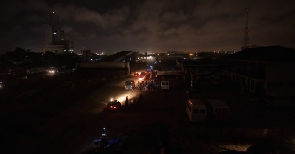 Ghana is experiencing an electricity power crisis
Ghana is experiencing an electricity power crisis
There is an ongoing conversation among particularly players in the power sector to have electricity price adjusted upward to enable the Ghana Grid Company (GRIDCo), the Electricity Company of Ghana (ECG) and Northern Distribution Company (NEDCo) to raise enough revenue to retool the power transmission and distribution networks, to ensure reliable power supply.
Well enough. It is easy to say Ghanaians are not paying cost-reflective tariff for electricity and as a result price increases is justified if one is oblivious of the real “cost components” used in the determination of the cost per kilowatt-hour (KWh) of the commodity.
It may interest consumers to know that among the many variables the Public Utility Regulatory Commission (PURC) considers in arriving at the cost per KWh of electricity, is allowable transmission and distribution losses.
For many years, the benchmark set for the losses have remained extremely high, compared to global industry average of 10 percent for both power transmission and distribution. In Asia, China is an example of a country with combined transmission and distribution loss benchmark of as low as 5.6 percent, and which has not recorded a total grid failure in the last 30 years. In Southern Africa with large grids, it compares with the global average of 10 percent.
In Ghana, the PURC allowable loss (benchmark) for the two streams was granted as 26.7 percent for 2019, a little above the 2016 benchmark of 25 percent. What this means is that the regulator have agreed to accommodate losing more than a quarter of the power generated by the country. The most disappointing aspect is that even though the PURC offers the transmitter (GRIDCo) and distributors (ECG/NEDCo) that high benchmark for losses, the utilities records annual losses, sometimes in excess of 30 percent.
Today, it is on public records that the ECG and NEDCo are losing millions of dollars on annual basis in revenue, due to system inefficiencies. The Institute for Energy Security’s (IES’) analysis of data from the Energy Commission (EC), shows that in 2019 for instance, the combined transmission and distribution loss stood 29.4 percent of total power transmitted (approximately 18,000 GWh), with a corresponding monetary value of approximately US$725 million; based on an average end-user tariff of US$0.137/KWh.
Using PURC’s allowable loss margin of 26.7 for 2019, the actual revenue loss incurred by GRIDCo, ECG and NEDCo, was found to be roughly US$67 million. However, based on the global combined benchmark of 10 percent and sub-Saharan Africa’s (SSA) average of 18 percent, the revenue loss to the three utilities is estimated at US$478 million and US$281 million respectively.
This means that there could be enough cash to begin to address the technical inefficiencies in the distribution network should the bit about the ECG and NEDCo’s commercial inefficiencies relating to cash collection from power consumed be saved. To the extent that the ECG can easily address the commercial inefficiencies (which constitutes than 55 percent of total distribution losses) in the system to save money, increasing tariff at this particular moment, can easily be interpreted as “endorsing and promoting inefficiencies”.
We are not in normal times. Jobs have been lost, pay-cuts has been occasioned, and money cannot be borrowed easily; thanks to Covid-19. The least distributors can do is to make available consistent but reliable electricity to consumers, and not to introduce additional financial burden to consumers.
It must be noted also that any attempt to raise the cost of electricity for industries, without addressing first the current instability in power supply, would lead to an increase in captive power generation. That is to say, high cost of power may force industry to move away from the national grid, leading to more stranded (excess) power.
Additionally, if the PURC supervises any tariff increase, Ghana’s power sector would become uncompetitive in the regional electricity trade via the West Africa Power Pool (WAPP). Government on many occasions has said that the country is unable to sell its excess power capacity to Togo, Benin, and Burkina Faso because of high tariff. So increasing cost per kilowatt-hour of electricity would produce extra excess power.
As a result, ECG and NEDCo, as a matter of urgency must interrogate their cost profiles for transmission and distribution, value addition and others, to place them on the path of recovery and profit-making. Because in other jurisdictions where utilities are recording profits, they do that largely on the basis of system improvement through innovation, and not necessarily through tariff increment. In addition, the PURC will outlive its usefulness and objectivity if it is compelled to approve of any tariff increase for ECG and NEDCo.
- ECG provided inaccurate reasons for recent power outages - PURC report
- PURC exposes ECG for falsely attributing ‘dumsor’ to overloaded transformers
- ECG could be made to replace your appliance damaged by 'dumsor' – PURC
- Thumbs up PURC – Edward Bawa lauds ECG sanctioning
- PURC fines ECG board members GH¢5.8 million for dumsor timetable breaches
- Read all related articles












